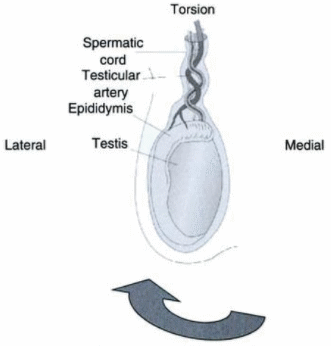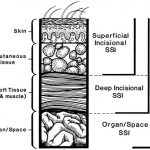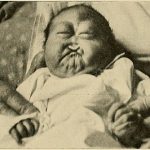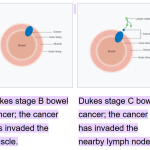Indications of Manual Detorsion
It can serve as a temporizing measure to attempt to reperfuse the testis while the patient is awaiting definite surgical management.
Contraindications of Manual Detorsion
- Manual detorsion is not recommended for torsion of duration >6-8 hours (prolonged ischemia leads to marked swelling and edema after which manual detorsion is not effective)
- Manual detorsion should not delay scrotal exploration and bilateral orchipexy in the operating room.
- It is indicated only in acute testicular torsion. Attempting this maneuver in epididymitis and torsion of appendix testis although may not be harmful, will be extremely painful and of no benefit.
Procedure of Manual Detorsion
Testis twist with inward rotation in 70% cases of testicular torsion and the average number of twist in cord is 2 (720 degrees).
1. A dose of analgesic and/or short-acting axiolytic may be used to blunt the discomfort of detrosion.
2. Physician is positioned in front of the standing or supine position.
3. Affected testicle is held with thumb and forefinger of the opposite hand, i.e. physician’s right hand for left testicle and physician’s left hand for right testicle.
4. Testis should be turned caudal to cranial (lifting slightly upward to release cremasteric reflex) and 180 degrees or more from medial to lateral (“opening a book”).
5. Rotation of testicle may need to be repeated 2-3 times for complete detorsion.
6. If the first attempt is unsuccessful, the testis should be turned in the opposite direction.
Signs or Markers of Successful Detorsion
1. Immediate resolution of pain
2. Restoration of anatomy (resolution of transverse lie of testis to vertical or longitudinal configuration)
3. Eventual return of cremasteric reflex
4. Color doppler ultrasonogram shows return or improvement of flow
5. Lower position of testis in the scrotum
Following successful manual detrosion, elective bilateral orchidopexy is recommended to, to prevent recurrent torsion and protect the contralateral side from torsion.
References:
- An Illustrated Guide to Pediatric Urology By Ahmed H. Al-Salem
- Essential Emergency Procedures edited by Kaushal Shah, Chilembwe Mason
- Textbook of Pediatric Emergency Procedures edited by Christopher King, Fred M. Henretig






